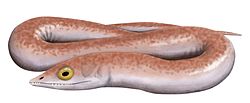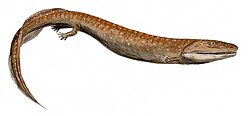| Carbonoherpeton | |
|---|---|
| Scientific classification | |
| Domain: | Eukaryota |
| Kingdom: | Animalia |
| Phylum: | Chordata |
| Clade: | Sarcopterygii |
| Clade: | Tetrapodomorpha |
| Order: | † Embolomeri |
| Genus: | † Carbonoherpeton Klembara, 1985 |
| Type species | |
| Carbonoherpeton carrolli Klembara, 1985 | |
Carbonoherpeton is an extinct genus of embolomere which lived in the Pennsylvanian (late Carboniferous) of Nova Scotia, Canada. [1]





